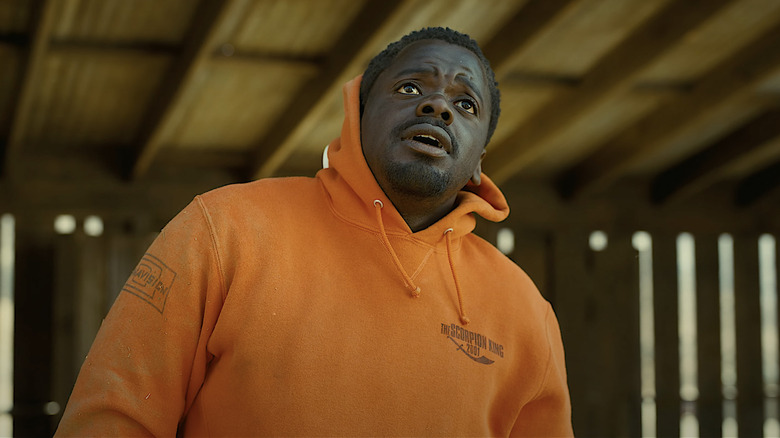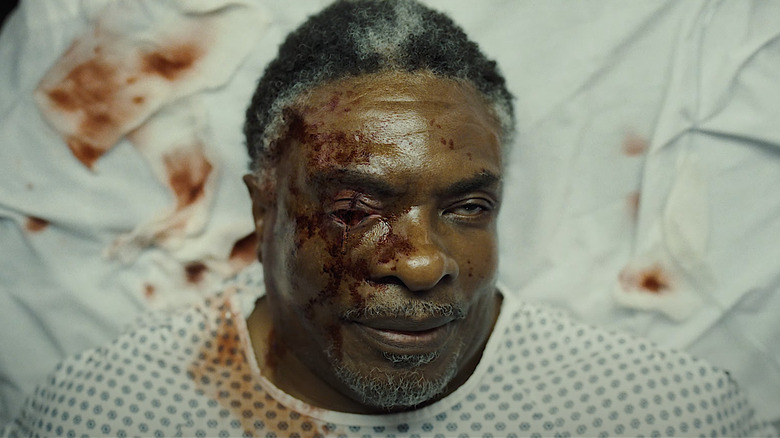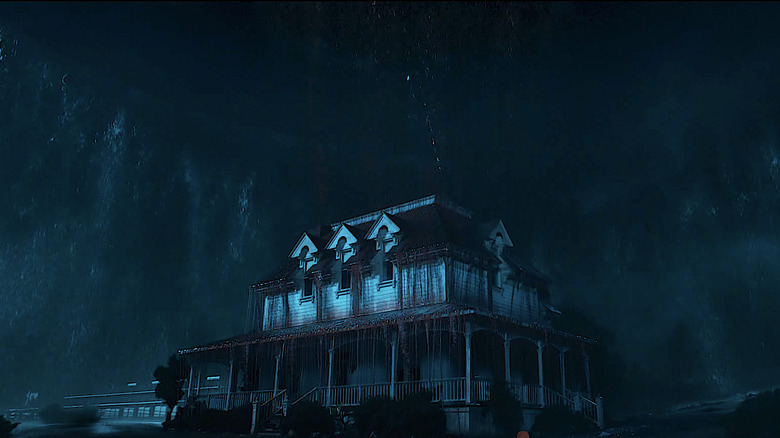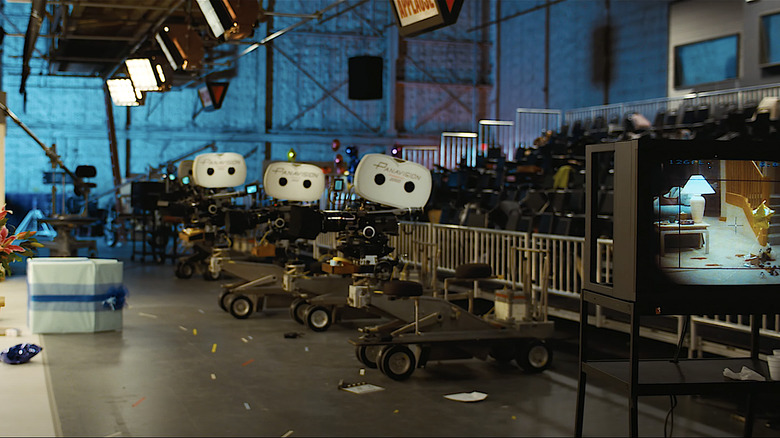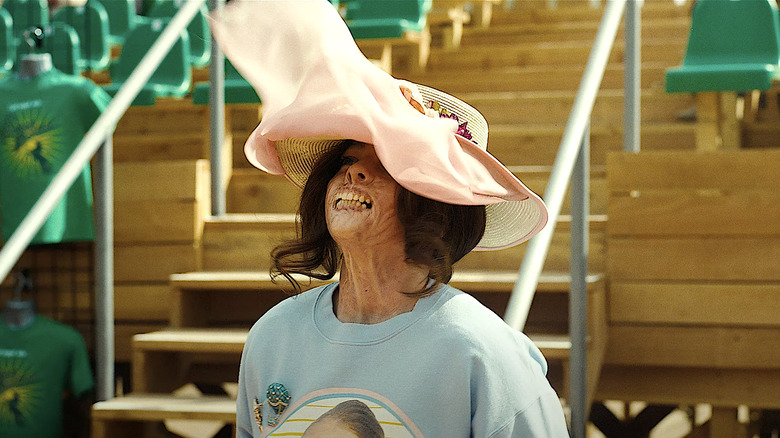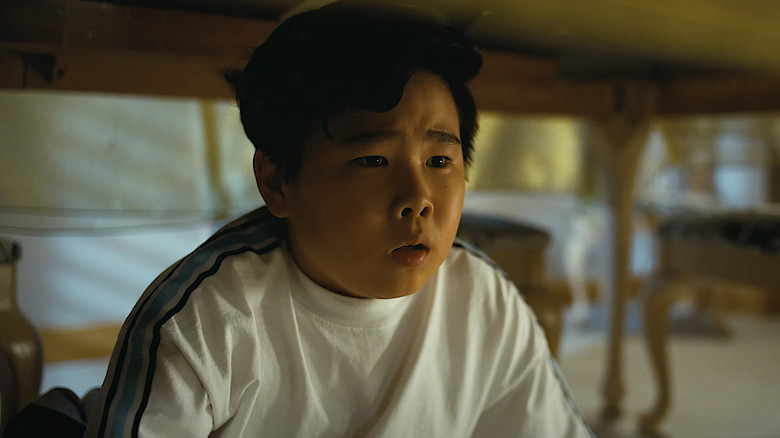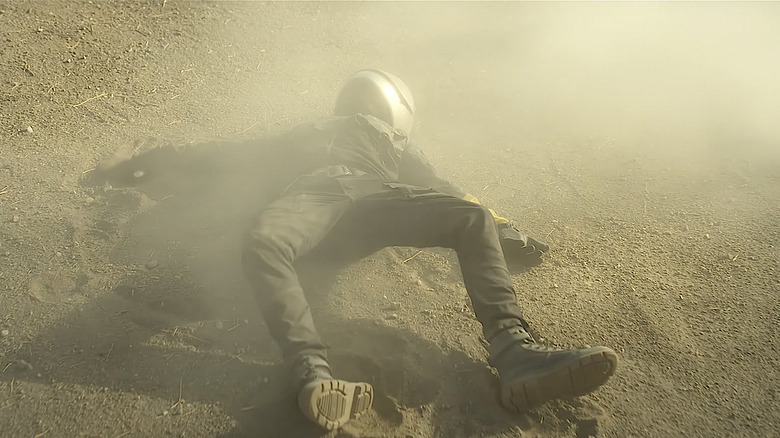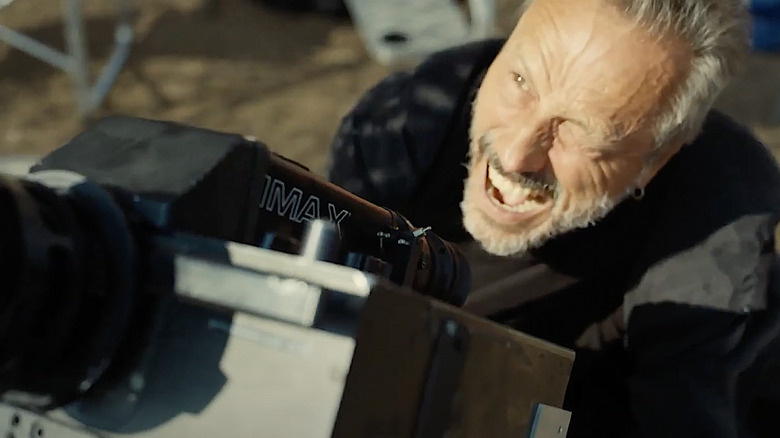The Most Brutal Moments In Nope, Ranked
Warning: This article contains major spoilers for Jordan Peele's "Nope."
Jordan Peele's third film "Nope" is a slow-burn UFO suspense-thriller. There are brutal moments for sure, but Peele's coy camera has much in common with the methodical M. Night Shyamalan. Coincidentally, Shyamalan followed his first two hits with a similarly suspenseful alien creature feature in "Signs." "Nope" also borrows from Steven Spielberg movies like "Jaws" as two Hollywood horse trainers risk it all to capture proof of a flying saucer. "Nope" is a movie about making movies, and about the seemingly universal hunger for viral fame. The enigmatic nature of UFOs stands in for the contest to capture public attention.
Peele's other genre twist is that this flying saucer is actually a ravenous monster itself. It's a supernatural apex predator that sucks up its prey with a whirling vortex. The alien eats its victims alive and spits out the rest. The director takes his time getting to this reveal to envelop you in the story of three Hollywood hangers-on who see little green men from beyond as their ticket to earthly attention. This is also the first horror movie shot on IMAX cameras and it looks incredible. Peele tapped Christopher Nolan's go-to large format shooter Hoyte van Hoytema ("Interstellar," "Dunkirk") as the film's cinematographer. IMAX captures the beauty of the Agua Dulce desert outside of Los Angeles, even at night, like nothing you've ever seen. It also gives immense scale to the brutal force that is both hunting humans from above, and savaging the selfie-taking culture.
7. Mysterious objects falling from the sky
The first death in a good horror movie should pose a question about the nature of the evil at work. Legendary Hollywood horse trainer Otis Haywood Sr. (Keith David) is saddled up at his sprawling California desert ranch. He's the descendant of the first movie star, of sorts, the Black man riding a horse in the historical series of photos from 1878. Otis' son, OJ Haywood (Daniel Kaluuya), looks on as suddenly a hail of objects starts falling from the sky. OJ is unharmed, but when he looks over, his father's horse is wandering off course and the family patriarch is unresponsive.
Cut to a frantic car ride to the hospital. Otis is leaning against the passenger window covered in blood as OJ tries to keep him conscious. Next, there's a quiet shot as OJ sits solemnly next to a body on a hospital gurney. The room is bright and there are no doctors working away. When the X-ray image comes on-screen, there is a U.S. nickel embedded in Otis' brain. Then it's the money shot, and it is brutal. The coin entered Haywood's eye. He never had a chance. At one point viewers can also see a key embedded in the hide of Otis' horse. OJ is told all this refuse fell from a plane, but as he says, "That never made sense to me." Jordan Peele's script hooks you instantly with this brutal and mysterious death.
6. The bloody house
Jordan Peele layers on topical themes that will keep you thinking about his movies, but he also conjures up some equally memorable images. In the final act, the flying saucer monster is dubbed Jean Jacket by OJ, named after a horse the viewers learn was meant to be Emerald Haywood's (Keke Palmer) first horse when she was a kid. That's how the Haywoods come to understand and contend with this monster from beyond. They treat it like a temperamental stage animal because that's what they know best.
OJ and Emerald's plan to capture the "Oprah shot" of this alien and save their ranch hits a stormy patch when Jean Jacket has a gruesome bout of indigestion. The creature has just had a particularly big meal, but inorganic matter doesn't suit this beast. That's when it unleashes a flood of blood and keys and more coins right on top of the Haywood home. The entire ranch looks like a gruesome crime scene as blood drips down the white wood, pouring down the banisters and front porch. It's an iconic image harkening back to the similarly brutal and bloody elevator shot in Stanley Kubrick's "The Shining." This sequence is unnerving, but it also plays a part in figuring out a crucial weakness the alien has. Peele leans heavily on "Jaws" as a reference, but unlike that indiscriminate man-eating monster, Jean Jacket has a delicate tummy, which may be the key to bringing it down.
5. Gordy the murderous chimp
"Nope" is a horror movie about making a horror movie as sibling horse trainers try to capture the impossible shot: genuine, clear photographic proof of a real UFO. The film is full of cameras, filmmaking, and filmmakers. Given how meta this story is, it's fitting the film's chilling and effective opening shot is of something gone horribly wrong on a studio set. There's a woman prostrate on her back, but the view of her and the disordered room is obscured. She's partially behind a couch but one of her shoes is strangely turned up and standing on a point in one of the film's ominous "bad miracles." That's when Gordy the chimp emerges. He's wearing a bright yellow sweater and both the garment and his face are covered in blood.
Later the audience learns this was the set of a '90s family sitcom "Gordy's Home" with a form factor a little like "Alf." During one episode, "Gordy's Birthday," some balloons trigger the overworked animal, and he snaps. He bludgeons the female lead of this show half to death and then leans in and eats her face off camera. It's not until the end viewers learn the film's opening shot was actually the vantage of the sitcom's child star as he hid from the killer primate. Once again, Jordan Peele doesn't show us too much. The brutality is mostly done by implication, and it's all the more gruesome in fans' imaginations.
4. Gordy's disfigured second victim
The Gordy subplot seems to have been inspired by a real chimp mauling in 2009. A Connecticut couple raised Travis the chimp in their home almost from birth until he snapped in a hideous display of primal strength. Travis attacked a woman, ripping off her nose, gouging out and eating her eyes, tearing off her fingers, and nearly an arm. Somehow she survived but was hideously disfigured. Audiences don't initially know the extent of Gordy's rampage, but from the opening shot, you suspect there are more victims.
Steven Yeun plays Ricky "Jupe" Park. He's the "Gordy's Home" child star who survived the attack, all grown up. He runs a wild-west theme park based on his other well-known child-star role, but now he's marginally famous at best. The real jewel of his empire is a macabre museum to the Gordy incident. But now, the UFO sightings have turned his wild west act into a viewing exhibition for the visitor from beyond. During Jupe's stage show, he introduces his former costar, Mary Jo Elliot. She played the teenage daughter on "Gordy's Home," and now her fate has been revealed. She's sitting quietly in the bleachers, wearing a large hat with an attached veil, completely obscuring her face. The implication is clear. When the alien does appear it blows up her veil as the wind picks up, and the tragic truth is clear: Gordy didn't eat cake on his birthday episode; he ate Mary Jo's face.
3. Gordy's death
In the real case of Travis the chimp eating a woman's face, there were warning signs. Travis lived in the home of a Connecticut couple and was treated as a human member of the family. He watched TV and even had his own pet cat. He was also a local celebrity so when he took off his seatbelt in traffic one day and chased after a pedestrian in a defiant incident that lasted hours, authorities somehow decided he wasn't a danger. Things really changed when Travis' adopted father died in 2004. The chimp was badly bereaved and would turn photos of his adopted father face down. Travis slept in the bed of his adopted mother and was even known to drink wine and Xanax was later found in his system, apparently given to him to calm his nerves. It was five years later he snapped and tore off a woman's fingers and face. When police arrived they shot Travis four times at point-blank range, ultimately killing the chimpanzee.
Gordy's end is similarly dramatic. After the rampage on the set of "Gordy's Home," Gordy notices young Jupe hiding under a table. He approaches slowly and reaches out his fist. Terrified, Jupe reaches back to perform their familiar fist bump. Just before they touch, a shot rings out and blood spatters the table cloth between the two friends, with some of the gore landing on the child's face. It's an effectively sudden end to a suspenseful subplot that lasts the length of this film.
2. The death of TMZ
During the climactic showdown with the man-eating flying saucer Jean Jacket, a mirage appears in the California desert that nails down writer-director Jordan Peele's primary theme in "Nope." It's a TMZ-style reporter on an electric motorcycle. He's gotten wind strange things are blowing over the skies of the Haywood ranch and wants the scoop via the DLSR and smartphone mounted to one overstuffed gimbal. He's also faceless in an eerily reflective helmet. Mirrors are a trope in "Nope," as they reveal what so many people are most obsessed with, but they spook the animals, too.
The anonymous TMZ reporter is the culture encroaching on OJ and Emerald's desert discovery. Initially, he tries to ambush-interview Emerald. She warns him to leave but the reporter guns it toward Jean Jacket. Everyone here is willing to risk their lives for content. Jean Jacket happens to also be something of a flying EMP. He eats humans whole and effectively shuts down their little content machines. Everything electric in its path goes dead. That's inconvenient for chasing viral videos, but also for the reporter going 60 MPH on an electric bike. As he approaches, his wheels lock up and he's hurled over the handlebars in a bone-crunching fall. Emerald tries to save him, but hilariously, the TMZ guy wants a selfie in his mangled state first. This delay is his doom. Peele doesn't drown the audience in brutal gore, but his pet themes are layered on thick.
1. The death of the director
Pugilistic prankster and video maker Logan Paul went viral for his negative review of "Nope," which hilariously misses the theme. Many were quick to point out the irony considering Paul, of suicide forest fame, is known for the exact content-beast culture "Nope" is satirizing. On this theme some were also mystified by the death of the director character, Antlers Holst, played by the irreplaceable Michael Wincott, in his juiciest role since "The Crow." He's in charge of the film the Haywoods are fired from in the opening act when the crew refuses to listen to OJ's warnings about how to behave around the stage horse, causing the animal to lash out. However, Holst is an obsessive auteur who spends his days going over old footage of a boa constrictor successfully subduing a full-grown tiger. Talk about an impossible shot! When he hears about OJ and Emerald's plan to get something even more elusive on film, he shows up ready to roll with a hand crank camera.
In the final scene, Holst captures the shot from under the safety of a camouflage tarp but this Captain Ahab-type can't help himself. He grabs his camera and runs up the mountain towards Jean Jacket. As the creature's vortex sucks him aloft, Holst cranks away, shooting his feet floating above the ground, and then, gets a shot directly into the belly of the beast. This is the ultimate impossible shot, and not one he survives. It's also Jordan Peele's climactic statement on the value of content in today's culture: It's worth more than life itself.
If you or anyone you know is having suicidal thoughts, please call the National Suicide Prevention Lifeline by dialing 988 or by calling 1-800-273-TALK (8255).
